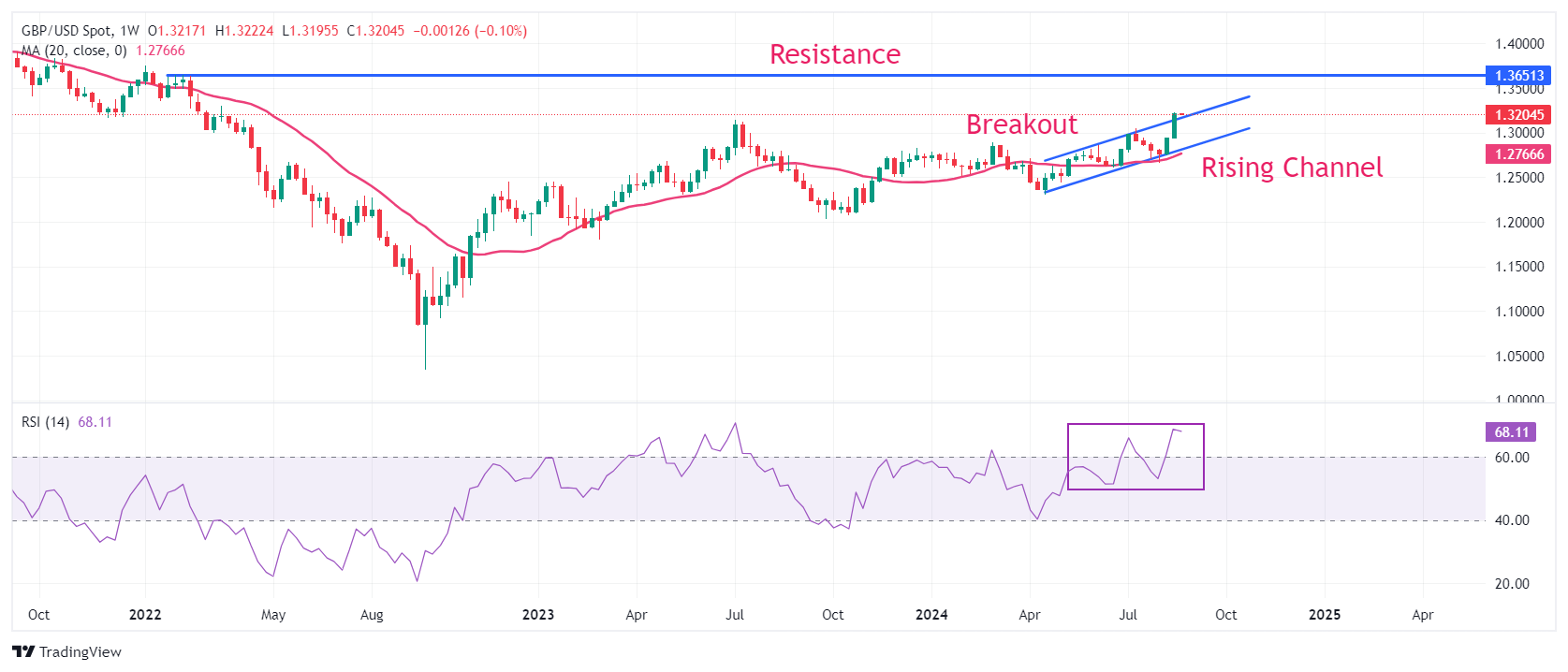- The Pound Sterling holds strength against the US Dollar to near 1.3200 driven by the Fed’s Powell dovish guidance on interest rates.
- Fed Powell’s comments suggested he remains concerned over downside risks to the US labor market.
- BoE’s Governor Andrew Bailey refrained from committing a specific interest-rate cut path.
The Pound Sterling (GBP) trades close to an almost two-and-a-half-year high near 1.3200 against the US Dollar (USD) in Monday’s North American session. The GBP/USD pair aims to extend its seven-day winning streak as the US Dollar weakens after the unambiguous announcement from Federal Reserve (Fed) Chair Jerome Powell, who said that the central bank will start cutting interest rates in September.
The US Dollar Index (DXY), which tracks the Greenback’s value against six major currencies, hovers near a fresh year-to-day (YTD) low of 100.53.
In the speech at the Jackson Hole (JH) Symposium on Friday, Fed Powell said: “The time has come for policy to adjust.” However, he refrained from committing to a preset interest-rate cut path and preferred to remain data-dependent, saying that "the direction of travel is clear, and the timing and pace of rate cuts will depend on incoming data, the evolving outlook, and the balance of risks."
Powell’s comments indicated that the central bank is now more worried about deteriorating labor market conditions and that he is confident that price pressures will return to the desired target of 2%. He commented that upside risks to inflation have diminished and downside risks to the labor market have increased. “We will do everything we can to support a strong labor market as we make further progress toward price stability," Powell added.
This week, the major trigger for the US Dollar will be the United States (US) core Personal Consumption Expenditure Price Index (PCE) data for July, which will be published on Friday. Month-over-month, PCE inflation is estimated to have grown steadily by 0.2%.
Meanwhile, the US Census Bureau has reported stronger-than-projected Durable Goods Orders data for July. New Orders for Durable Goods, a key measure of core consumer inflation, grew at a robust pace of 9.9% from the estimates of 4%. Nothing will come from the Pound Sterling side as the United Kingdom (UK) is on a bank holiday.
Daily digest market movers: Pound Sterling rises as BoE to pursue slower policy-easing process
- The Pound Sterling performs strongly against its major peers at the start of the week. The British currency gains as the Bank of England (BoE) is reluctant to offer a preset rate-cut path given that the victory over inflation in the UK is far from over.
- BoE Governor Andrew Bailey signaled in his speech at the JH Symposium on Friday that the second-round effects of inflationary pressures could be smaller than expected, but added that the central bank should not rush for more interest rate cuts, Reuters reported. The BoE would "be careful not to cut interest rates too quickly or by too much," Bailey said.
- Andrew Bailey also ruled out the risks of a potential recession and assured that the steady disinflation in the UK is aligned with the aim of achieving a soft landing for the economy.
- This week, the Pound Sterling will be guided by the market speculation for BoE interest rate cuts amid an absence of top-tier economic data in the UK. Currently, market participants expect that the BoE will deliver one more interest-rate cut this year. The BoE opted for a cut on August 1, with a close 5-4 split among its Monetary Policy Committee members. However, a slew of upbeat economic data, including stronger-than-expected flash S&P Global/CIPS PMI for August, has weighed on expectations for another rate cut in September.
British Pound PRICE Today
The table below shows the percentage change of the British Pound (GBP) against listed major currencies today. The British Pound was the strongest against the New Zealand Dollar.
| GBP | EUR | USD | JPY | CAD | AUD | NZD | CHF | |
|---|---|---|---|---|---|---|---|---|
| GBP | -0.04% | -0.22% | -0.38% | -0.27% | 0.06% | 0.10% | -0.38% | |
| EUR | 0.04% | -0.16% | -0.26% | -0.21% | 0.07% | 0.18% | -0.30% | |
| USD | 0.22% | 0.16% | -0.10% | -0.06% | 0.32% | 0.32% | -0.15% | |
| JPY | 0.38% | 0.26% | 0.10% | 0.07% | 0.52% | 0.66% | 0.03% | |
| CAD | 0.27% | 0.21% | 0.06% | -0.07% | 0.37% | 0.41% | -0.12% | |
| AUD | -0.06% | -0.07% | -0.32% | -0.52% | -0.37% | 0.10% | -0.39% | |
| NZD | -0.10% | -0.18% | -0.32% | -0.66% | -0.41% | -0.10% | -0.50% | |
| CHF | 0.38% | 0.30% | 0.15% | -0.03% | 0.12% | 0.39% | 0.50% |
The heat map shows percentage changes of major currencies against each other. The base currency is picked from the left column, while the quote currency is picked from the top row. For example, if you pick the British Pound from the left column and move along the horizontal line to the US Dollar, the percentage change displayed in the box will represent GBP (base)/USD (quote).
Technical Analysis: Pound Sterling hovers near 1.3200
The Pound Sterling softens slightly against the US Dollar but remains close to 1.3200 after delivering a breakout of the Rising Channel chart formation on the weekly time frame. The GBP/USD pair posts a fresh, almost two-and-a-half-year high, and it is expected to extend its upside towards the February 4, 2022, high of 1.3640.
The upward 20-week Exponential Moving Average (EMA) near 1.2766 suggests a strong upside trend.
The 14-period Relative Strength Index (RSI) oscillates in the bullish range of 60.00-80.00, suggesting a strong upside momentum. Still, it has reached overbought levels at around 70.00, increasing the chances of a corrective pullback. On the downside, the psychological level of 1.3000 will be the crucial support for the Pound Sterling bulls.
US Dollar FAQs
The US Dollar (USD) is the official currency of the United States of America, and the ‘de facto’ currency of a significant number of other countries where it is found in circulation alongside local notes. It is the most heavily traded currency in the world, accounting for over 88% of all global foreign exchange turnover, or an average of $6.6 trillion in transactions per day, according to data from 2022. Following the second world war, the USD took over from the British Pound as the world’s reserve currency. For most of its history, the US Dollar was backed by Gold, until the Bretton Woods Agreement in 1971 when the Gold Standard went away.
The most important single factor impacting on the value of the US Dollar is monetary policy, which is shaped by the Federal Reserve (Fed). The Fed has two mandates: to achieve price stability (control inflation) and foster full employment. Its primary tool to achieve these two goals is by adjusting interest rates. When prices are rising too quickly and inflation is above the Fed’s 2% target, the Fed will raise rates, which helps the USD value. When inflation falls below 2% or the Unemployment Rate is too high, the Fed may lower interest rates, which weighs on the Greenback.
In extreme situations, the Federal Reserve can also print more Dollars and enact quantitative easing (QE). QE is the process by which the Fed substantially increases the flow of credit in a stuck financial system. It is a non-standard policy measure used when credit has dried up because banks will not lend to each other (out of the fear of counterparty default). It is a last resort when simply lowering interest rates is unlikely to achieve the necessary result. It was the Fed’s weapon of choice to combat the credit crunch that occurred during the Great Financial Crisis in 2008. It involves the Fed printing more Dollars and using them to buy US government bonds predominantly from financial institutions. QE usually leads to a weaker US Dollar.
Quantitative tightening (QT) is the reverse process whereby the Federal Reserve stops buying bonds from financial institutions and does not reinvest the principal from the bonds it holds maturing in new purchases. It is usually positive for the US Dollar.
Information on these pages contains forward-looking statements that involve risks and uncertainties. Markets and instruments profiled on this page are for informational purposes only and should not in any way come across as a recommendation to buy or sell in these assets. You should do your own thorough research before making any investment decisions. FXStreet does not in any way guarantee that this information is free from mistakes, errors, or material misstatements. It also does not guarantee that this information is of a timely nature. Investing in Open Markets involves a great deal of risk, including the loss of all or a portion of your investment, as well as emotional distress. All risks, losses and costs associated with investing, including total loss of principal, are your responsibility. The views and opinions expressed in this article are those of the authors and do not necessarily reflect the official policy or position of FXStreet nor its advertisers. The author will not be held responsible for information that is found at the end of links posted on this page.
If not otherwise explicitly mentioned in the body of the article, at the time of writing, the author has no position in any stock mentioned in this article and no business relationship with any company mentioned. The author has not received compensation for writing this article, other than from FXStreet.
FXStreet and the author do not provide personalized recommendations. The author makes no representations as to the accuracy, completeness, or suitability of this information. FXStreet and the author will not be liable for any errors, omissions or any losses, injuries or damages arising from this information and its display or use. Errors and omissions excepted.
The author and FXStreet are not registered investment advisors and nothing in this article is intended to be investment advice.
Recommended content
Editors’ Picks

AUD/USD oscillates in a range below mid-0.6200s; seems vulnerable
AUD/USD stabilizes below mid-0.6200s following the previous day's good two-way price swings amid confusion over Trump's tariff plans. The Aussie, meanwhile, remain close to over a two-year low touched last week in the wake of the RBA's dovish shift, China's economic woes and US-China trade war fears.

USD/JPY bulls retain control near 158.00/multi-month peak
USD/JPY retests multi-month top during the Asian session on Tuesday and looks to build on the momentum beyond the 158.00 mark. Doubts over the timing when the BoJ will hike rates again and the recent widening of the US-Japan rate differential – led by the Fed's hawkish shift – continue to undermine the JPY and support spot prices.

Gold price struggles to lure buyers amid hawkish Fed, elevated bond yields
Gold price trades with a negative bias for the third straight day on Tuesday, though it lacks follow-through amid uncertainty over Trump's tariff plans. Moreover, the recent USD pullback from over a two-year high and geopolitical risks support the safe-haven XAU/USD.

Ripple's XRP eyes massive rally following spike in key on-chain metric
Ripple's XRP trades near $2.40, up 1% on Monday following a 40% surge in its futures open interest. The surge could help the remittance-based token overcome the key resistance of a bullish pennant pattern.

Five fundamentals for the week: Nonfarm Payrolls to keep traders on edge in first full week of 2025 Premium
Did the US economy enjoy a strong finish to 2024? That is the question in the first full week of trading in 2025. The all-important NFP stand out, but a look at the Federal Reserve and the Chinese economy is also of interest.

Best Forex Brokers with Low Spreads
VERIFIED Low spreads are crucial for reducing trading costs. Explore top Forex brokers offering competitive spreads and high leverage. Compare options for EUR/USD, GBP/USD, USD/JPY, and Gold.
